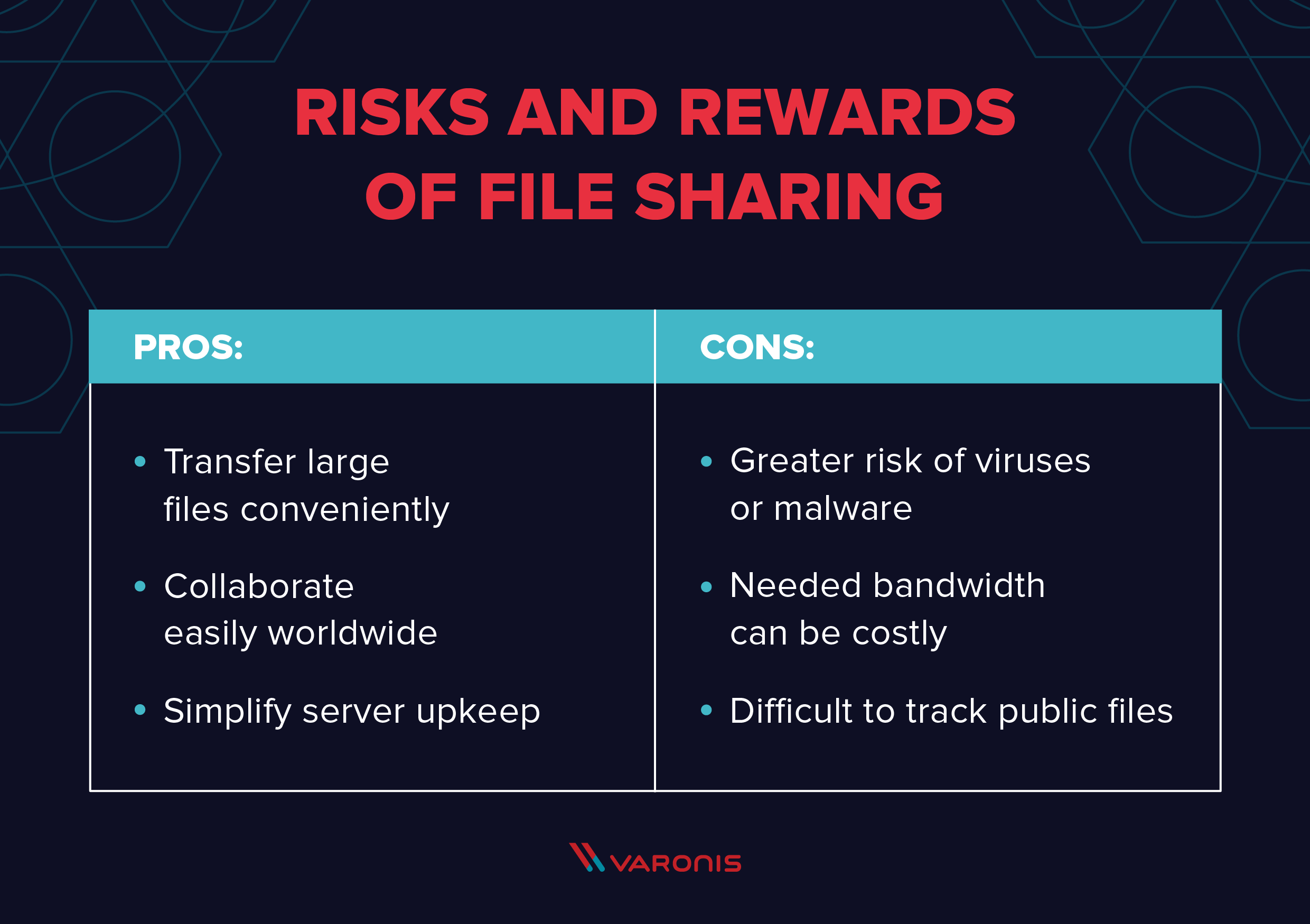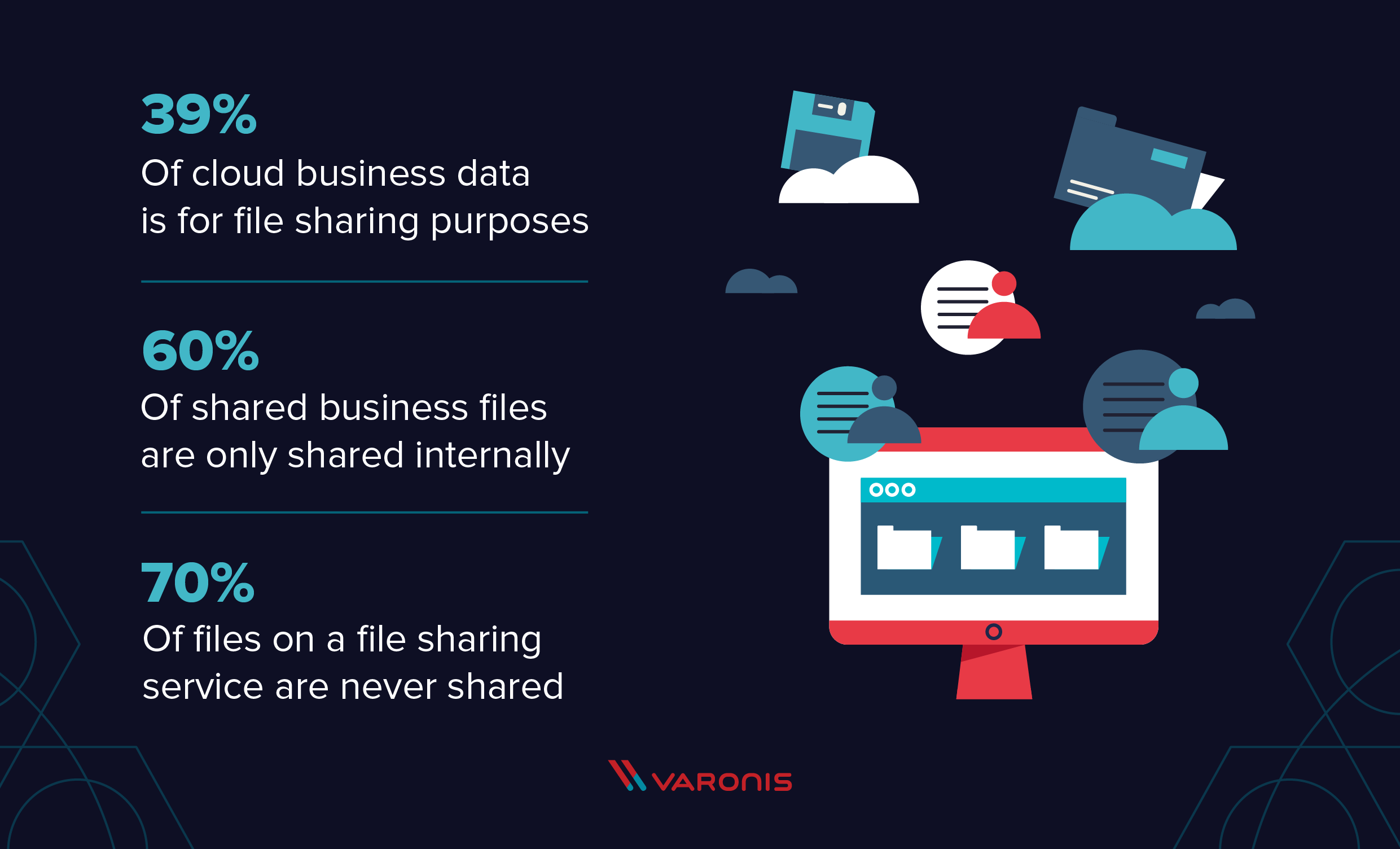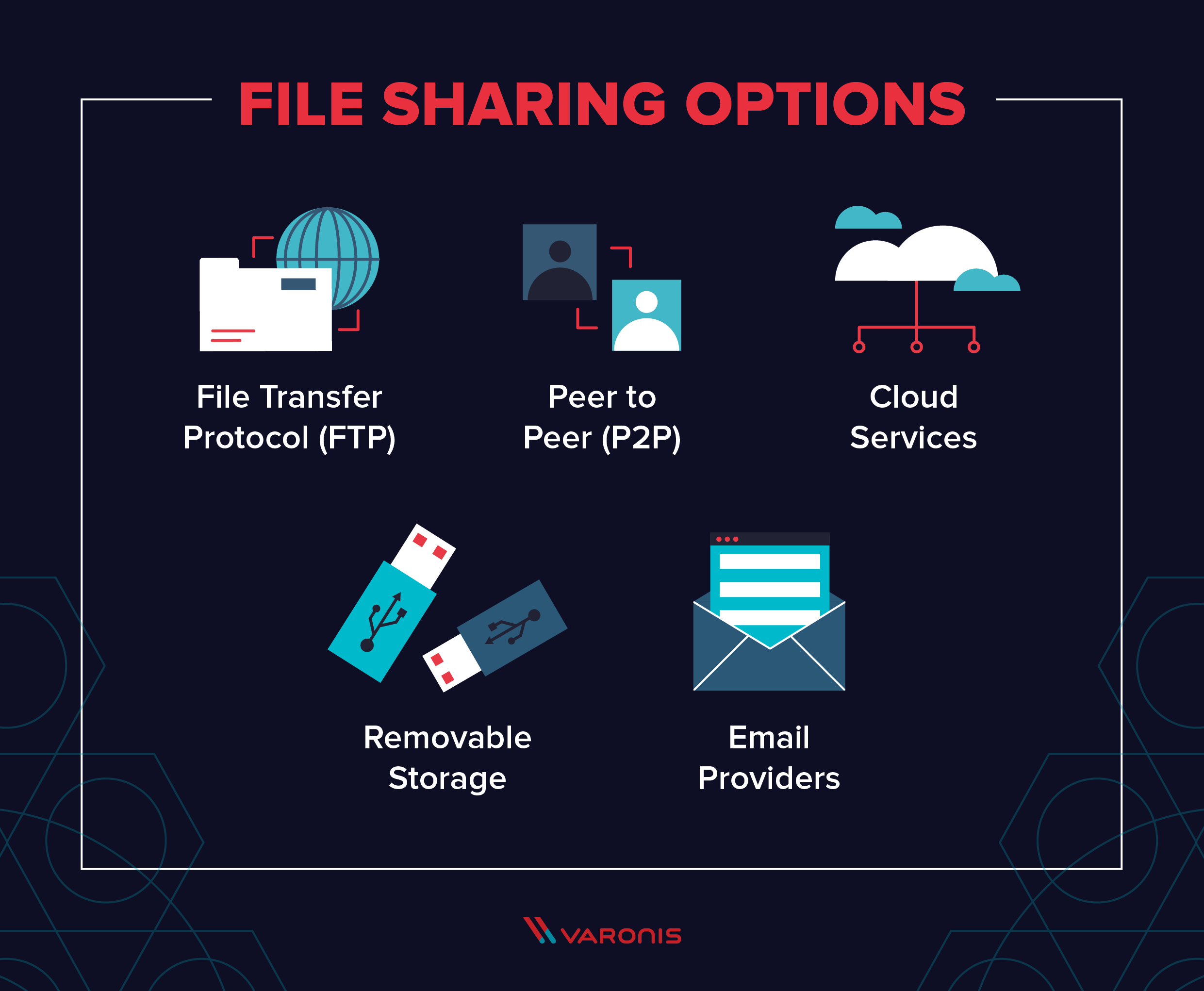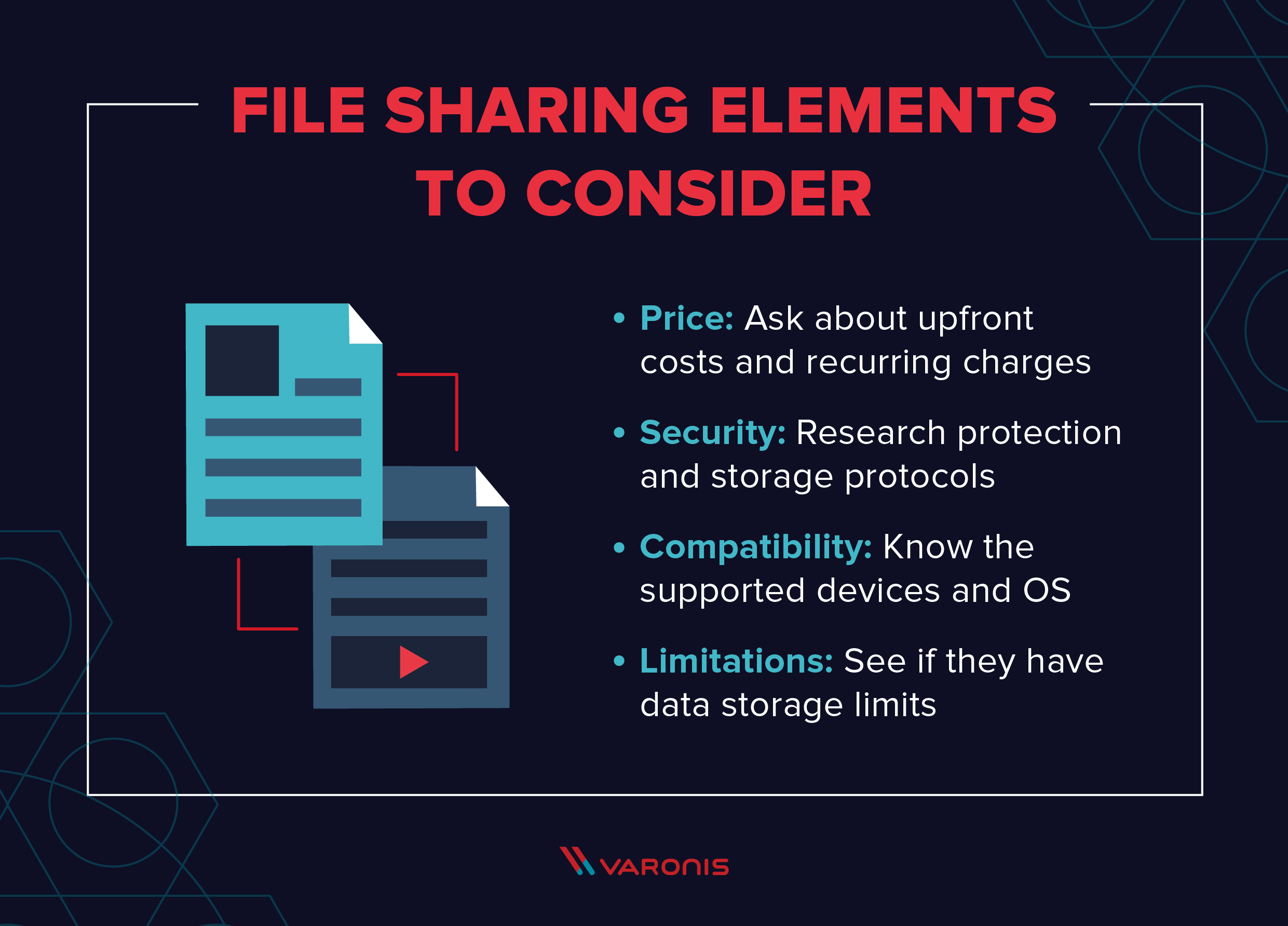Place to Upload Files for Sharing Up to 400mb
It'southward phenomenal to call up well-nigh how much digital data is transmitted over the cyberspace on a daily, hourly, or even minutely footing. Every time a spider web page is loaded or a file is downloaded, a back and forth transaction occurs. All the same sometimes it tin can however feel like a claiming to find a product or tool that is capable of treatment file sharing on a regular basis.
In this article, we'll wait at the unlike scenarios where file sharing is useful so dive into specific solutions for accomplishing your goals. Keep in mind that you lot should only share and transfer information that you created or that does non have copyright restrictions tied to information technology. Varonis Data Classification Engine can assist identify all of the information avails on your various systems.
Acquire how to automate Microsoft 365 management with our gratis PowerShell form
Bank check out our free security training courses, like our Microsoft Office 365 hidden settings class that includes disquisitional security settings and counts for CPE credits.
- Types of File Sharing
- How to Select Your Platform
- ten File Sharing Solutions
- File Sharing FAQs
What is File Sharing?

Today'south computers are capable of storing all types of files, including documents, songs, videos, and full applications. When you move i or more files from your local computer to another device or remote location, you are partaking in the action of file sharing. In some scenarios, the recipient volition take to have the file, only typically the transfer volition complete automatically.
What Are The Pros and Cons of File Sharing?
In that location are a number of factors to continue in mind before you start actively file sharing. Let'south walk through some of the key positives and negatives about the process.
Pros
- Allows yous to transfer large files over a network connection.
- Makes information technology easier to collaborate with other people across the globe.
- Reduces the need to maintain a key file server that is always online.
Cons
- Amount of bandwidth required can be plush.
- Difficult to trace what happens to a file after it is shared publicly.
- Higher chance of acquiring a virus or other type of malware from a remote file.
File Sharing Stats

When the topic of file sharing comes up, almost people call up the days of tools like Napster which became pop methods for illegally transferring music content around the internet in the 90's. Today, however, file sharing is a primal function for many businesses and other use cases. Let'south examine some statistics related to file sharing.
- 39% of business data that is uploaded to the cloud is used for file sharing purposes.
- The average company shares files with over 800 dissimilar online domains, which includes partners and vendors.
- Almost 60% of files uploaded to a file sharing service are never actually shared with other people and are instead used as a backup copy.
- Virtually seventy% of shared files are spread to only internal users in an organization.
Tips: Secure File Sharing for Businesses
Now allow'southward accept a look at some of the best practices when it comes to ensuring your file sharing sessions are secure at all times.
- Choice a service that offers finish-to-terminate encryption. This protects you from external hackers and also prevents the host itself from viewing your information.
- Ever double-cheque permission settings. Near services allow for a public sharing option, merely that means that anyone with the right link can obtain your files.
- Run audits on your files to see who is accessing them. If a file is no longer needed, remove it from your cloud system entirely.
Types of File Sharing

Before y'all can start distributing files over the internet, you lot need to determine what method and protocol you want to employ. Your determination should be based on what types of files you are moving and who will be receiving them. We'll swoop into the main options and explain what scenarios they can help with the most.
File Transfer Protocol (FTP)
FTP was 1 of the first methods invented for moving data across networks and it remains very popular today thank you to its reliability and efficiency. FTP actions can be run through a command prompt window or a tool with a user interface. All information technology requires is for you lot to specify the source file you want to move and the destination where information technology should be placed.
- Great for: Big files, unusual file types, or legacy data.
- Example programs: FileZilla, Telnet, WinSCP.
Peer to Peer (P2P)
The purpose of a P2P file transfer is to remove the need for a central server that hosts the information. Instead, individual clients connect to a distributed network of peers and complete the file transfers over their own network connections. P2P might somewhen be used to create an unstoppable TOR. Whether or not The Onion Router (TOR) is a truly P2P environment depends on many factors, but its popularity in creating a more than secure online connectedness is unquestioned.
- Smashing for: Sharing files with a small group of people, files that are unavailable in public repositories.
- Example programs: Limewire, Gnutella, BearShare.
Cloud Services
With a cloud file sharing service, 1 user uploads their data to a central repository then other users can download the files to their ain devices. All information is hosted past a third political party provider, although users tin can specify what types of permission levels to put on the files.
- Keen for: Fast sharing of files, creating backups of data.
- Example programs: Dropbox, Box, OneDrive, iCloud.
E-mail Providers
Some people don't realize that email tin actually function as a file transfer system. Every fourth dimension you lot attach a certificate to an outgoing message, y'all are initiating a transfer of that data over the open internet.
- Great for: Small files, data that needs explanation.
- Example programs: Gmail, Outlook, Yahoo! Mail.
Removable Storage
When no network-based option will fulfill your needs, you can always rely on a physical drive to serve as your file transfer operation. This means you lot are literally copying data to a USB flash drive or external hard drive and plugging that device into the destination calculator.
- Groovy for: Massive files, sensitive information.
- Example programs: USB thumb drives or external hard drives.
How to Select the All-time File Sharing Option

Once yous've determined what method of file sharing you volition use, it's time to pick an individual service or product. This can exist challenging because of how many options there are, ranging from established companies to new get-go-ups. Here are some tips of things to consider when selecting a file sharing solution.
- Toll — You'll desire to know how much the service costs upfront and on a monthly or yearly basis. In some cases you may also take to pay for the bandwidth used during a transfer.
- Security — If you are going to trust a deject provider with hosting of your data, make certain to enquiry how that information is stored and what is done to protect it.
- Compatibility — Find out what types of devices and operating systems will support the file transfers. If some of your users are non comfortable with new engineering, expect for options that have simple interfaces.
- Limitations — Before making a big investment in a file sharing service, make sure to identify any limits or restrictions the provider has in terms of the number of files shared or the full amount of data stored.
In well-nigh cases, a cloud-based solution will meet your file sharing needs. For personal use, y'all'll find a range of costless options. When it comes to file sharing at the enterprise level, you'll want to look for a tool that is robust and flexible. The alphabetized list below will help yous narrow downward the choices.
1. Box
Box was one of the very outset cloud-based file storage services to gain popularity. It allows users and organizations to centralize all of their data and collaborate with other people. Box offers a free pick for individual users and a broad range of paid plans for enterprises.
- Great for: Big companies that need to manage huge data systems beyond the globe.
- Pros: Integrates well with enterprise security systems, allows for workflow configuration, meets compliance requirements.
- Cons: Cheaper plans are very limited, difficult to preview files from computers and devices.
- Pro tip: Enable email alerts to automatically get notified when a document gets uploaded or changed.
2. Dropbox
Dropbox seeks to provide a unmarried place for individual users and organizations to store all of their of import data. Syncing is a big focus of Dropbox, equally information technology has native applications for mobile devices and allows you to take your files on the go.
- Great for: Pocket-sized and medium-sized businesses that do not require advanced features, users looking to support disquisitional data.
- Pros: Large network of users so it is easier to share documents deeply, files are always encrypted, integrate desktop experience.
- Cons: Personal free plan only includes 2 GB of storage, new collaboration solutions can be confusing.
- Pro tip: Check the version history of a document to see how it has inverse over fourth dimension or even recover information technology if it has been accidentally deleted.
3. Egnyte
Egnyte caters mainly to business users who want to retain tight control over every file shared inside or outside of the organization. It comes with many advanced features out of the box and likewise allows you to integrate its services with your own applications through an application programming interface (API).
- Great for: Companies who need to transfer confidential data, organizations that support various devices and operating systems.
- Pros: Extra backup copy is saved during every file transfer, adheres to highest encryption standards, robust mobile access.
- Cons: Harder to use than some basic services, customer support tin can be lacking.
- Pro tip: Administrators can share files and create custom dashboards for each individual user.
4. Google Drive
Google Drive was one of the get-go companies to bring document collaboration to the deject with its Google Docs suite of browser-based tools. The platform behind that is Google Bulldoze, which also works equally a great file sharing service.
- Smashing for: People who already accept a Gmail account, small organizations that don't want to worry about local storage.
- Pros: New users get 15 gigabytes for free, files can exist shared with any electronic mail address.
- Cons: Collaboration requires a Google business relationship, tin can exist difficult to see sharing settings.
- Pro tip: Upload images and let Google Bulldoze extract text from them for searching.
5. iCloud Drive
Apple has steadily been releasing improvements to its iCloud suite of online software. New Mac computers and iOS devices now come with iCloud Drive already installed so that files tin be synced automatically.
- Neat for: Users who utilize Apple products at dwelling house and at work, file sharing betwixt Apple users.
- Pros: Frees up storage space on local hard bulldoze, integration with iMessage and other Apple services.
- Cons: Limited integration with Windows, new users only get v GB of storage, limited business organization support.
- Pro tip: Endeavour out the family sharing options to easily share images and videos beyond multiple users.
6. MediaFire
MediaFire is a pocket-size just growing cloud-based storage platform that can be used in a browser or on mobile devices. It aims to be a simplified file sharing solution for users who don't crave fancy features.
- Great for: Quick file transfers from ane person to some other, users who like to share via email.
- Pros: No bandwidth limitations, fast majority downloads, handles multiple uploads through a browser.
- Cons: Bones plan includes on-screen ads, limited collaboration options.
- Pro tip: Configure a i-time link so that you can make certain your files are non shared more than once.
7. OneDrive
As Microsoft has moved many of its cadre concern products to the cloud, their OneDrive tool has become an essential office of the Windows operating organization. Private users can back-upward their data and create shared folders across an system.
- Smashing for: Businesses that use PCs with Windows, individuals with an Outlook email business relationship.
- Pros: Integration with Sharepoint, granular permission setting, easy to utilise with Office.
- Cons: No support for Mac OS, can suffer from irksome upload and download speeds.
- Pro tip: Use the OneDrive mobile app to automatically back up all of your photos to the cloud.
8. SecureDocs
SecureDocs is considered a virtual data room and is designed to cater to businesses that are pursuing mergers or acquisitions and need to manage secure document sharing. The company offers a flat monthly pricing construction that includes access for an unlimited number of users. They also offer single-sign-on options for your existing enterprise authentication tools.
- Smashing for: Instances where security is the meridian priority.
- Pros: Drag and drop folders, flat-rate pricing, one of few providers offering unlimited accounts.
- Cons: Challenging to configure permissions, limited integration.
- Pro tip: Plough on ii-factor authentication to boost security.
9. SugarSync
SugarSync tin be run on Mac or Windows computers so that users can hands sync folders to their deject business relationship. It first launched in 2008 and caters to both consumer and business users. Their security standard is equivalent to that of the banking industry.
- Great for: Users with messy folders, businesses without a backup solution.
- Pros: Easy to restore files online, tin can create public links to documents.
- Cons: No free plan option, syncing speeds tin be slow.
- Pro tip: View snapshots of your synced documents at any bespeak in time.
x. WeTransfer
WeTransfer aims to be the simplest file sharing service to use by reducing the authoritative effort. The company was founded in 2009. Their primary service allows you lot to send any file to an email address or create a one-time link that other people tin can access.
- Great for: One-time file transfers.
- Pros: Extremely fast and piece of cake to apply, no account required.
- Cons: Limit of ii GB per transfer, no security features.
- Pro tip: Upgrade to a business concern account to track download history.
File Sharing FAQ
Here are a few common questions that come up when discussing file sharing.
Q: What are Some Techniques for File Sharing?
A: The nearly common ones are physically sharing a deejay device, using an FTP connection, or uploading data to a cloud-based system.
Q: How to Set Up a Secure Abode Office Network for File Sharing?
A: With more than and more people working from home and remote offices, it's important to secure your network with a virtual private network (VPN) client before doing whatever file sharing.
Q: What is the Most Secure Online File Sharing Software?
A: Virtual data rooms like SecureDocs that are designed to handle sensitive information.
Q: Why does file sharing cost money?
A: Although data storage is relatively cheap, hosting providers charge for storage space as well as bandwidth costs.
Information is ofttimes an organization's most valuable asset and should be secured with a tool like Varonis Data Security Platform. File sharing is easier than ever, only it's important to keep your files as locked down as possible in order to prevent a costly information breach.
Source: https://www.varonis.com/blog/secure-file-sharing
0 Response to "Place to Upload Files for Sharing Up to 400mb"
Post a Comment